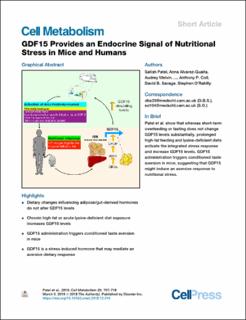GDF15 provides an endocrine signal of nutritional stress in mice and humans
Patel, Satish; Álvarez-Guaita, Anna; Melvin, Audrey; Rimmington, Debra; Dattilo, Alessia; Miedzybrodzka, Emily L.; Cimino, Irene; Maurin, Anne-Catherine; Roberts, Geoffrey P.; Meek, Claire L.; Virtue, Samuel; Sparks, Lauren M.; Parsons, Stephanie A.; Redman, Leanne M.; Bray, George A.; Liou, Alice P.; Woods, Rachel M.; Parry, Sion A.; Jeppesen, Per Bendix; Kolnes, Anders Jensen; Harding, Heather P.; Ron, David; Vidal-Puig, Antonio; Reimann, Frank; Gribble, Fiona M.; Hulston, Carl J.; Farooqi, I. Sadaf; Fafournoux, Pierre; Smith, Steven R.; Jensen, Jørgen; Breen, Danna; Wu, Zhidan; Zhang, Bei B.; Coll, Anthony P.; Savage, David B.; O'Rahilly, Stephen
Peer reviewed, Journal article
Published version
Permanent lenke
https://hdl.handle.net/11250/2647644Utgivelsesdato
2019Metadata
Vis full innførselSamlinger
- Artikler / Articles [2096]
- Publikasjoner fra Cristin [1084]
Sammendrag
GDF15 is an established biomarker of cellular stress. The fact that it signals via a specific hindbrain receptor, GFRAL, and that mice lacking GDF15 manifest diet-induced obesity suggest that GDF15 may play a physiological role in energy balance. We performed experiments in humans, mice, and cells to determine if and how nutritional perturbations modify GDF15 expression. Circulating GDF15 levels manifest very modest changes in response to moderate caloric surpluses or deficits in mice or humans, differentiating it from classical intestinally derived satiety hormones and leptin. However, GDF15 levels do increase following sustained high-fat feeding or dietary amino acid imbalance in mice. We demonstrate that GDF15 expression is regulated by the integrated stress response and is induced in selected tissues in mice in these settings. Finally, we show that pharmacological GDF15 administration to mice can trigger conditioned taste aversion, suggesting that GDF15 may induce an aversive response to nutritional stress.
Beskrivelse
This is an open access article under the CC BY license (http://creativecommons.org/licenses/by/4.0/).
